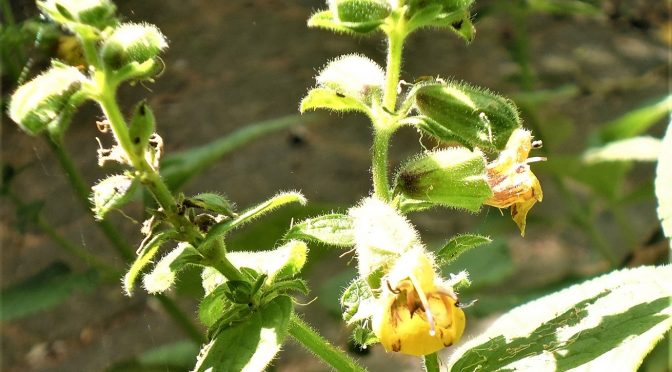Salvia omeiana: is a low growing clumping herbaceous perennial, 20-30cmH with large leaves and yellow flowers in late spring to summer.

Salvia omeiana is a robust clumping perennial from the hillsides of Sichuan.
Flowers: are a butter yellow, falcate with a long tube. As the flowers are initially facing downwards to allow the insect to crawl up into the corolla. The thick tube protrudes out and up, so the corolla opens outwards allowing the insects easier access to the flower. Often the tube will wear reddish brown stripes along it’s length.
The hood is straight, bulbous with a rib along the central line, occasionally it can have a slight purple tinge. The pale stigma is exerted from the tip with the purple or brown anthers very evident. These colourings’ all help to attract insects from above to the flower. The colour of the anthers will also indicate to the insect if the flower has been visited and old or new and can be visited.
The 2 side lobes are small and flared out to help open up the throat area. The middle lobe is long and falls down, again to open up the throat area to allow the insect easy access to the throat area.
While the beeline is not very evident, the coloured anthers take on that roll and guide the insect further into the corolla and at the same time brush against the anthers and stigma while trying to move into the corolla.
Flowers are held in whorls of 4-6 flowers, held at regular intervals along a green slightly hairy stem. The whorls all face downwards to allow the insect to crawl up into the flower. Inflorescences are simple panicles of flowers which can reach 20-30cmH from an established plant, all held well above the foliage to attract passing insects.
Flowering can be from late spring through early summer. They are spent by midsummer. Most insects will be bees and beetle that can crawl up into the flower rather than flies or moths.
Calyces: are green initially with the tips colouring to brown, all facing downwards. Lobes are strongly ribbed, slightly hairy with blunt points. If not pollinated, these drop off leaving an empty green stem. If the flower is pollinated, then the calyx turns a straw colour and remains until the seeds drop out of the calyx.
Leaves: are large, mid green, fissured and hairy with a long petiole. They can either be rounded/ cordate or a hastate shape , often with the beneath being coloured purple, but the veins remaining green – a wonderful contrast.
The leaves form an open large basal mound , all facing upwards with the inflorescence held well above.
Salvia omeiana is a robust growing plant, forming large clumps. Coming from a woodland / hillside area, it enjoys dappled shade or a sunny well protected position away from hot dry winds and the hot summer sun.
As the growth is sturdy, it can be grown in a bed beneath deciduous trees or in a mixed woodland border with other small shrubs and perennials that enjoy similar growing conditions.
In summer, it does prefer mulching to keep the root area cool during the hot dry summer season, compost, leaf mould and additional watering at the height of the dry summer months.
In autumn, when the flowers have finished, collect any seed and cut down the old flower stems, old leaves and any debris around the crown. Mulch the crown to keep warm during the cold winter months, and use a marker to indicate the crown, so as not to accidentally dig up or be trodden upon.
In late winter, just before the leaves appear, feed well, top up the mulch, compost and leaf mould and watch for snails and slugs.
Propagation: usually from seed but side slips can be taken in early summer from well developed shoots.
Not available
Back to Varieties


